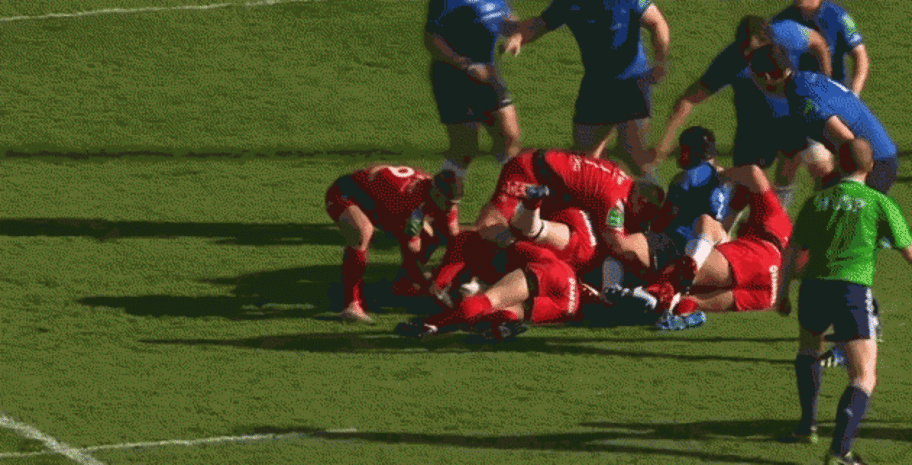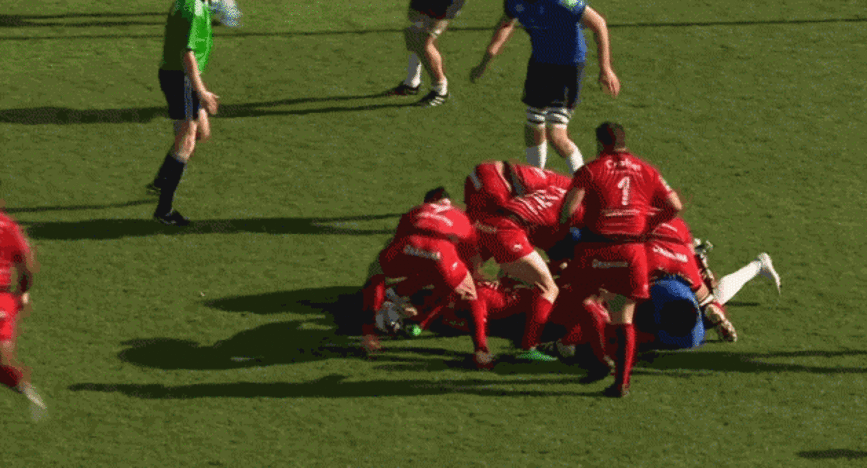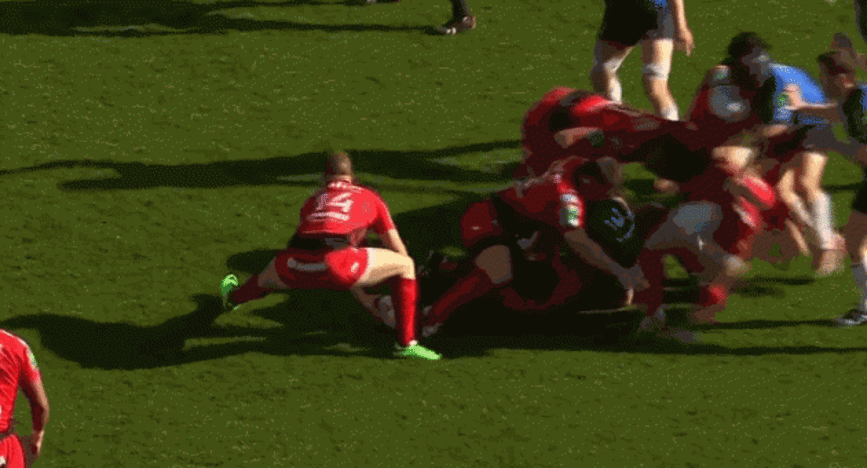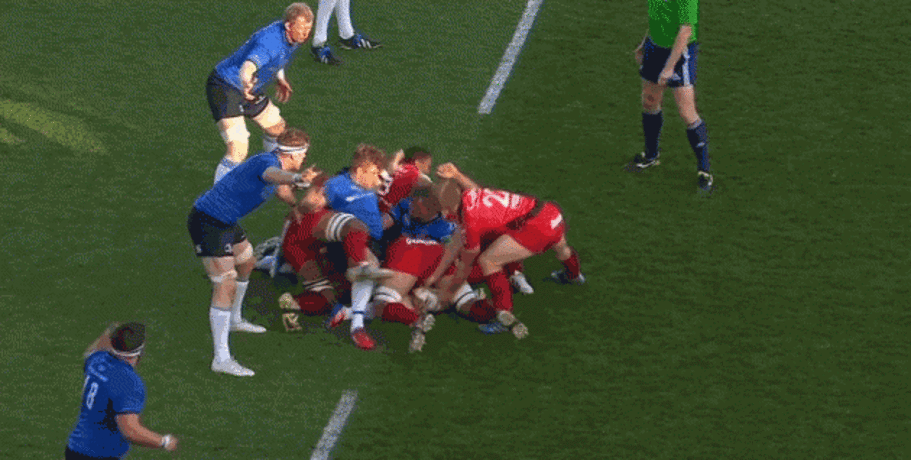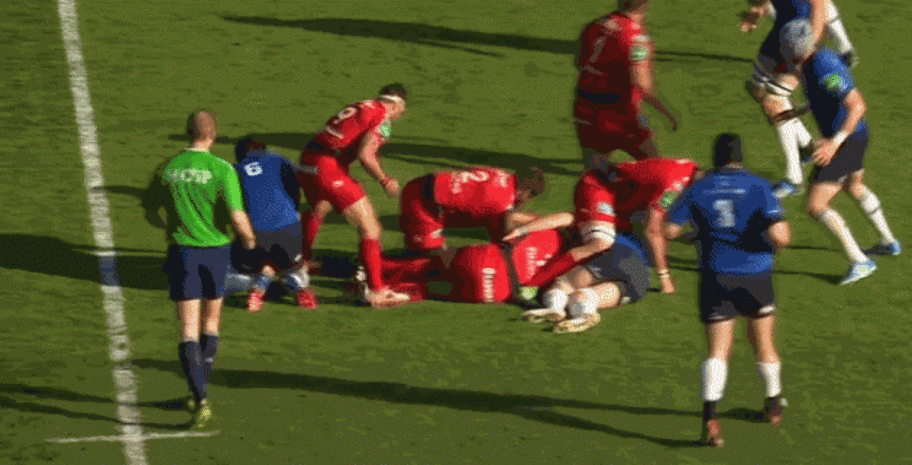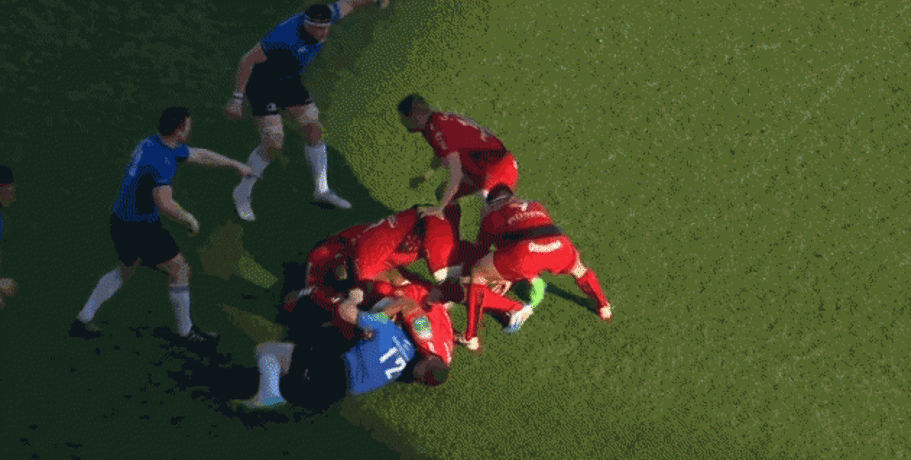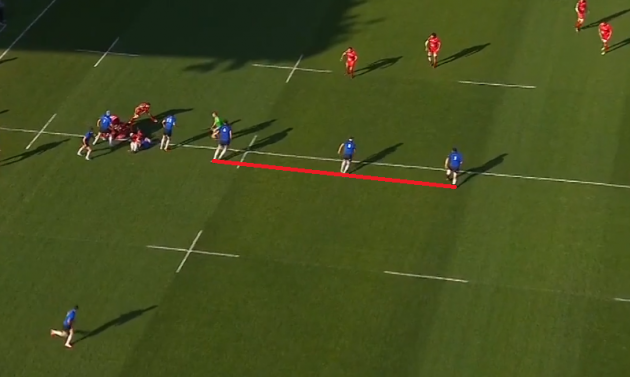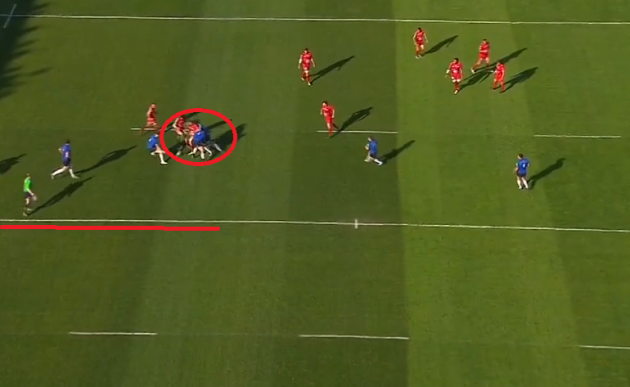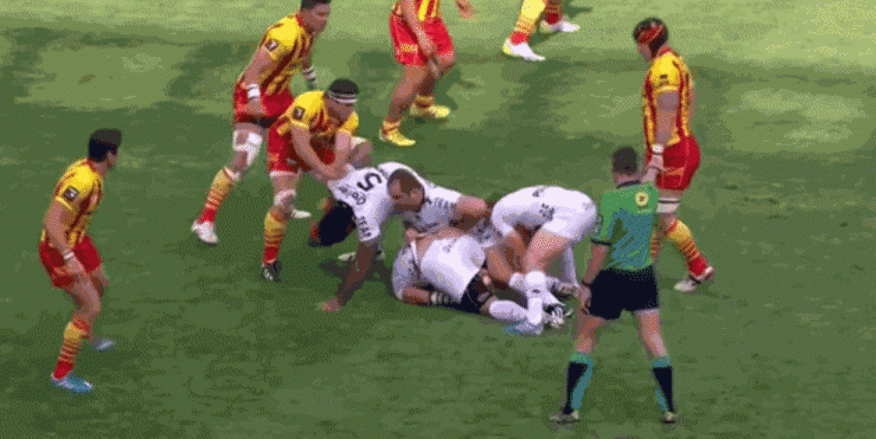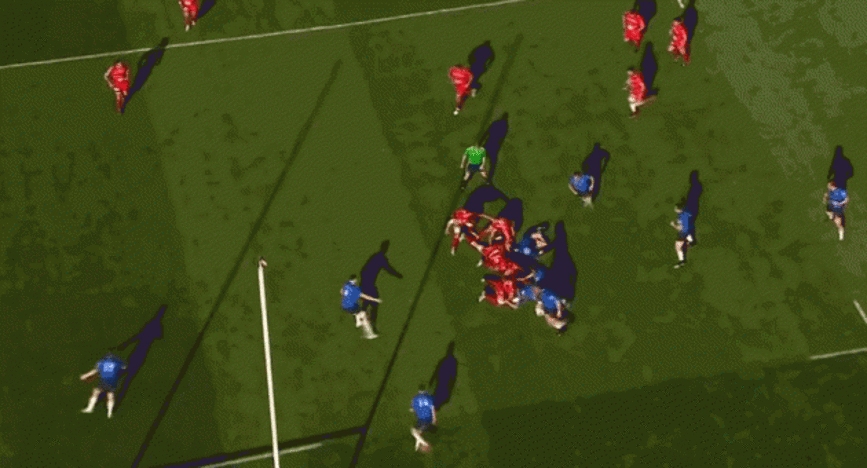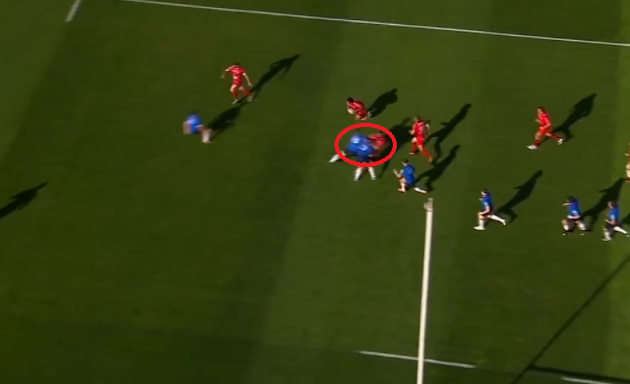“LE RUGBY, C’EST toujours pareil. C’est un – le combat, deux – le combat, trois – le combat.”
Bernard Laporte is a man who believes that the basis of rugby lies in the collisions, the fight for physical domination. That much is apparent in his Toulon side, who Munster have the thrilling task of overcoming for a place in this season’s Heineken Cup final.
The reigning European champions are far from one-dimensional, but so much of what they do is based around winning a high majority of contact situations. That was in clear evidence as they dismantled Leinster in the quarter-finals, although the eastern province would have been disappointed with their own physical efforts in that game.
Oddly enough, Munster will outweigh the Toulon starting XV if both teams are named as expected for Sunday’s game. [Munster at a combined 1,551kg to Toulon's 1,539kg as per the clubs' official websites]. However, there is more to athletic capability than simple weight.
Toulon are perhaps the most explosively powerful club team we have seen in modern European rugby, with unique specimens like Mathieu Bastareaud, Steffon Armitage, Danie Russouw and Carl Hayman leading the way.
A framework for the power to thrive
Toulon’s form has steadily risen through the course of the current season, building to the dominant victory over Leinster, when Laporte’s men gave easily their finest display of the campaign.
One reason for that is the mental strength the Toulon players possess, their ability to turn up on the big occasions and for the most important months of the season. An annual €31 million budget will buy you the best athletes, but also some of the most mentally capable players in the world.
On top of the individual and group mindsets that power Toulon, Laporte and his coaching staff of Pierre Mignoni and Jacques Delmas have added important flourishes to their side’s attacking shape.
When we think of Toulon attacking, images like the one below are recurring.
Danie Russouw takes a pass from scrum-half Sébastien Tillous-Borde, boshes through the tackle of Leinster’s Shane Jennings and gets his team bounding over the gain line. This instance is all about a one-off runner winning le combat and helping Toulon to progress.
Using the likes of Russouw, Armitage and Xavier Chiocci in this manner will certainly be part of Toulon’s attacking play in Marseille. So Munster just need to make straight-up one-on-one tackles to stop the Toulon phase play? It’s not that simple unfortunately.
As this season has progressed, the Top 14 side have added lots of pre and post-contact movement on the ball in the areas to either side of the ruck.
We get a relatively simple example of that above, with a short linking pass from Juan Smith [who has excellent hands] to Russouw. It’s a tactic that many teams use on this type of phase play off the scrum-half, but Toulon do it particularly well.
As we see in the GIF above, Leinster start in a decent defensive position, but when Smith shifts the little pass it just unsettles Jamie Heaslip and Jimmy Gopperth for a split second, and Russouw runs right over the top of the out-half.
In the clip below, we see a similar ploy by a pair of Toulon forwards, with an even more positive outcome.
Again, the short linking pass, this time from Armitage, allows Russouw to enter the collision in a far more favourable position. In turn, that means the former Springbok can get his hands free to give the offload back to his teammate.
Those little linking passes are not always made pre-contact, however. The example below shows Armitage receiving the ball from Tillous-Borde, just about winning his collision and then offloading to Jonny Wilkinson. That shifting of the focal point in attack allows Smith to power on through contact.
While the three examples above are typical of Toulon’s narrow attacking phase play, they also have a strong tendency to play off one of their backs at first receiver. Very often, that man is out-half Wilkinson, whose prompting in open play has perhaps been undervalued over the years.
The 34-year-old does not pose a great breaking threat himself, but he does excel at providing short pop passes to his forward runners, both inside and outside himself.
We see that in the animation above, with Wilkinson popping to Russouw and then Smith on his outside shoulder, facilitating their running game with one or two steps of his own before passing.
As all of the above shows, Toulon attacked quite narrowly against Leinster, targeting the fringe defence on either side of the preceding rucks. While that is not always their primary tactic [as we will touch on later], it certainly has been a strong feature of their best performances this season.
The forwards are not always the ones to do the damage in that zone, with some of the backline play coming in those narrow channels too.
The example above shows as much in action, with Matt Giteau and Maxime Mermoz combining on the switch and left wing David Smith running a delayed line to take an inside pass.
It’s worth noting how Leo Cullen vacates the ‘pillar’ position on Leinster’s left side of the ruck at at the start of the GIF. The veteran lock drifts out across the pitch, with Jamie Heaslip realising the threat and sprinting across before missing his tackle.
While Munster clearly want their inside defenders to work hard across the pitch when they need to do so, they equally must be aware of Toulon’s threat on the fringes. The French side’s busts of defensive lines in these areas have been catastrophic for several opponents this season.
Second-five-eighth
The clip above provides us with a nice lead in to the next area of Toulon’s attacking prowess. Matt Giteau has been perhaps the best inside centre in Europe this season, while also excelling in the out-half position on numerous occasions.
The 31-year-old is a creative playmaker and offers a huge running threat with his footwork and darting acceleration. 11 tries in all competitions are proof of that, but his real value is in directing some of Toulon’s best attacking play.
The video above provides us with an illustration of Giteau stepping in as first receiver and providing a medium-length pass, before carrying the ball himself on the next phase. That passing option is of particular value to Toulon, especially because Giteau combines it with excellent vision.
Some teams struggle in phase play if their out-half is briefly taken out of the action [when forced to hit a ruck for example]. However, Toulon cope and thrive in those scenarios, with Giteau stepping in and running play with confidence and intelligence.
The former Brumbies man loves having a cut at the line himself, and is particularly adept at spotting slow forwards in front of him and then darting in between them for a clean break of the defensive line.
That’s exactly what Giteau does above, stepping inside Mike McCarthy and outside Devin Toner to streak through untouched. Munster’s forwards will need to be particularly switched on in regards to that threat, especially inside their own half.
Learning from Leinster
One of the key lessons Munster will have taken from watching Leinster’s defeat to Toulon in the quarter-finals will have been around missed tackles. Clearly, the French side’s power played a major role, but 27 misses meant Leinster were in major trouble.
There’s not a huge amount to say about this issue on a technical level. Craig Burden is an excellent player but in the example above, the hooker should never be making a clean break.
Munster’s focus in the tackle has to be low, aggressive and decisive. They are not going to win every collision in the game, but they can prevent some of the psychologically damaging busts of their line that Leinster suffered at Stade Mayol.
If [and quite possibly when] Toulon do cut through the Munster defence, Rob Penney’s men will need to scramble swiftly and intelligently. if they do so, the manner in which Toulon often follow their breaks may even play into the hands of the visitors on Sunday.
We go back to the very first clip used in this piece, with Russouw running straight through Jennings. The focus this time is on the phases that follow, and again the intention is to highlight the importance of the fringe defenders.
A repeated habit in Toulon’s Heineken Cup performances this season has been the narrowness of their attack immediately following a break or half-break. Many teams look to spread the ball into wide channels when they have made their initial bust, but Laporte’s men very often follow up with narrow phase play.
Above, we see Giteau hitting Drew Mitchell with an inside pass, before Bastareaud picks and goes on his own. Leinster pull off the choke tackle, an area where Munster also excel. The point is not that Penney’s men can look to choke tackle after every Toulon break, but rather the manner in which the Top 14 side’s follow-up phases are isolated.
Mitchell is ripe for turning over if Jennings reacts in time to the glimmer of an opening, before Bastareaud gets himself utterly detached from the support and deservedly gets turned over. Munster will be alive to those opportunities.
Ideally, Penney’s men will not give up those line breaks and again, we look to Leinster for an example of how Munster might go about preventing them.
There are two facets to focus on in the clip. Firstly, Brian O’Driscoll gets in over the ball and competes for a steal and secondly, Leinster produce superb line speed to get into the Toulon faces and force an error.
O’Driscoll doesn’t actually win the ball on the deck, but he does managed to slow the ruck, thereby giving his teammates a split second of extra time to organise themselves in defence.
The result of that is Leinster getting off the defensive line with an aggression that was quite rare in the quarter-final.
The images above and below illustrate how far beyond the gainline Leinster force the error, and provides an example for Munster’s defence. Penney’s men won’t get the chance to rush up on every single phase, but when they do get an opportunity, they must be ruthless in taking it.
While Russouw knocks the ball on in this instance, there is an excellent defensive decision by Mike McCarthy immediately before the mistake. Munster’s forwards in these areas one or two passes away from the rucks will need to make many like it.
Finally, a brief word for the Toulon counter-attack against Leinster. Laporte’s men are not the most ambitious in terms of running the ball back from deep, but if Munster kick poorly from their own 22, the likes of Delon Armitage, Mitchell, Smith and Bryan Habana will counter with glee.
Constant effort and organisation on kick chase, as well as on all other defensive duties, is the key for Munster in preventing major gains for Toulon. There is nothing new or revolutionary in what the French side do; they simply do everything with pace, power and focus.
Wider options
The impression is of a team who attack largely through their powerhouse forwards, but Toulon do possess the ability to move the ball wide too. Their more expansive game plans are usually restricted to Top 14 clashes against weaker opposition, but Munster will need to be aware of the passing threat too.
Giteau is often the key man when Toulon look to ship the ball to the wings, stepping in as first receiver or passing long from the second receiver position. Wilkinson has a fine pass too [as does Frédéric Michalak when he plays 10], offering a dual playmaking option.
Bastareaud is a key man in much of the Toulon back play, for more than just his bulldozing runs. It’s not worth going into the 25-year-old’s individual running ability as it is so widely known, and it goes without saying that Munster will need to chop him low and get a second man on the ball to prevent the offload.
Physcially, James Downey and Casey Laulala are more than capable of handling Bastareaud, but the real test is in how Toulon use him as a decoy. Committing to the tackle early can often be the key to halting the 120kg centre, but doing so opens holes elsewhere in the defence.
The GIF above provides the perfect illustration, with Brian O’Driscoll biting in on Bastareaud as the Toulon centre runs a flat, hard decoy line. Wilkinson simply pulls the ball back behind Bastareaud, and suddenly Smith is in space.
A wonderful intercept by Rob Kearney saves Leinster in this instance, but more often than not Toulon will convert this chance into a try. Clearly, managing Bastareaud is a demanding task, but the Munster centres will be fully aware of his potential as a decoy.
There will be heavy onus on Casey Laulala in the 13 channel to make intelligent, swift decisions around whether to bite in on Bastareaud or slide off him in defence. Fortunately for Munster, the Kiwi centre has excelled in his defensive decision-making this season.
The mini-play above is one Toulon are particularly fond of using in midfield, meaning Munster’s defence in that slightly wider channel will need to be on its toes and clear-minded in reacting.
Armitage, le Toulonnais
Steffon Armitage is enjoying deserved widespread praise for his superb form, and the calls for him to be included in England’s squad ahead of next year’s Rugby World Cup look set to grow in the coming month.
L’Équipe are reporting that Stuart Lancaster was in Toulon this week to talk to Steffon and his brother about the possibility of coming back into the international frame, and it would seem foolish to ignore the back row.
The 28-year-old had a major influence on Toulon’s win over Leinster, making several incisive attacking runs and consistently excelling at the breakdown [as we will examine more closely elsewhere]. Again, there is little need to analyse Armitage’s ball carrying threat in open play as it is so clear and obvious.
He is a bundle of explosive fast-twitch fibres, with a violent fend and strong pre-contact footwork. Armitage’s move to No. 8 to cover for the injured Chris Masoe has worked out remarkably well, with the position very often allowing him to arrive at the breakdown after the initial tackle has been made.
In attack, Armitage’s re-positioning has allowed him to carry the ball directly from scrums, something we have seen less and less of from No.8s in the professional game in recent times.
The clip above shows an example of that just last weekend against Perpignan, and highlights the need for Munster’s flankers to be alert on the edges of each and every scrum.
A physical onslaught like no other
Penney and his men are fully aware of the physical challenge that awaits in the Stade Vélodrome on Sunday, one they will take on with typical aggression. Preventing the Toulon attack from making as much headway as it did against Leinster will take huge work-rate, high levels of organisation and extreme solidity close in to the rucks.
Picking up the line speed whenever possible would help to pressurise the Toulon carriers, even if Munster have not always rushed aggressively in defence this season. That involves clear risks, but those are necessary steps at this stage of the competition.
The physical power of Steffon Armitage and Mathieu Bastareaud is particularly crucial for the home team, but Munster have the players and system to halt them before the major damage is done. Fail to do so, and the task could become impossible.

